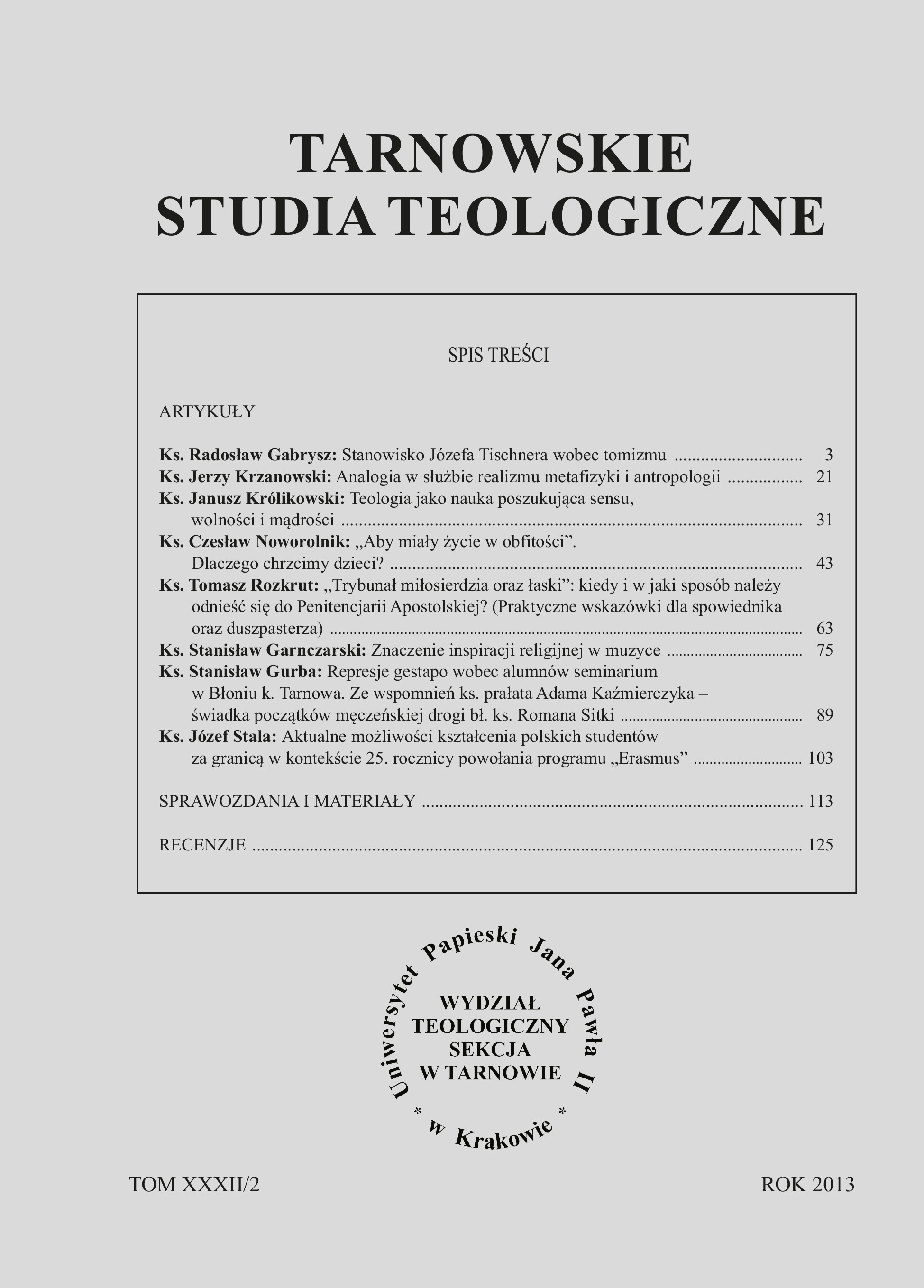„Aby miały życie w obfitości”. Dlaczego chrzcimy dzieci?
DOI:
https://doi.org/10.15633/tts.321Słowa kluczowe:
chrzest, sakrament chrztu, chrzest dzieci, zbawienie, wiara, konieczność chrztu, limboAbstrakt
The Article presents the issues regarding the sacrament of baptism as a gateway of faith, the source of Christian life and pledge of eternal salvation. Starting from considerations contained in the Document of the International Theological Commission “The Hope of Salvation for Infants Who Die without Being Baptised” (2007), author is trying to take a look on the practice of baptism of children and some elements of Catholic baptismal theology. The text is touching also the problem of limbo from the point of view of contemporary Magisterium of the Church.
After presenting in synthetic form biblical fundaments of the baptismal theology, and the practice of the Church regarding the baptism of children, the text introduces to the traditional doctrine of the Catholic Church regarding the necessity of baptism of children. The paper presents then the elements of the contemporary teaching of the Magisterium regarding the sacrament of baptism with the particular attention to the statements of the Second Vatican Council, the Congregation for the Doctrine of the Faith (Instruction on Infant Baptism Pastoralis actio), The Code of Canon Law, The Catechism of the Catholic Church, and the teaching of Pope John Paul II and Benedict XVI. The texts of the Magisterium and the development of studies of contemporary theologians allow to look in a new perspective on the practice of the Church regarding baptism of children.
Biblical, historical, and theological perspective of presentation of the problem leads to the conclusion that the question to be asked in relation to the baptism of children is not “whether or not baptize the children?” but “why should we baptize the children?”. The answer to that question is located in the dogma regarding salvation and in the dogma regarding sacraments as the tools necessary for salvation entrusted by Christ to the Church. The baptism is undoubtedly the sacrament of salvation. It is an instrument, which the Church has received from Jesus in order to transmit it to all the people.
The task of the Church is to pass this salvation to all the people. Fulfilling Christ’s mandate, the Church from the beginnings, proclaimed the Good News and baptized. Minimalistic understanding of that command of Jesus based on the logic of order and duty led the scholastic theology to develop of the theory of limbo. The obligation to fulfil some minimum for salvation have lead to seek a solution of dilemma concerning the destiny of those who will not be able to fulfil the order directly, that is to be baptized of water, or indirectly (in voto), which refers to the baptism of desire and the baptism of blood. The scholastic theology has proposed some substitute of salvation that is the theory of limbo puerorum. Limbo would be the substitute of eternal happiness for those children, who would not have any possibility to fulfil the minimum established by commandment.
From the perspective of the contemporary Magisterium, this minimalistic interpretation is insufficient. In order to understand the meaning of the sacrament of baptism we should change perspective. We must move our attention from the legal duties and conditions that the person must fulfilled in order to be baptized, and redirect it on God himself, on the One who is the source of the grace of baptism and all the spiritual gifts, all goods, which God gives to the man in this sacrament. In this perspective, baptism appears as the most precious gift of God by which Jesus Himself gives to the man the grace of faith and pledge of salvation. Baptism appears as an encounter in which God communicates with man, and endows him His love and life. The Sacrament of Baptism, especially the baptism of children, reminds a wonderful truth, which is gratuitousness of salvation. Baptism of children also proves that faith is a gift that initiates our way to the fullness of life. In this perspective, it would be difficult today to defend the theory of limbo. The Church practices to baptize the children not because of fear of the possibility of reduction and even deprivation of eternal beatitude of those who cannot fulfil some formal requirements to receive this sacrament. The practice of the infant baptism expresses the faith of the Church in the power of God’s love and His will to save every human being.
God has an infinite number of possibilities to provide salvation to man even outside of the sacrament of baptism. The Church has just only such a tool, and that is why the Church baptizes the children. The faith is the gift. The salvation is the most precious gift of God. The Church therefore desires share this wonderful gift with all the children, that they may have God, and have life, and have it in abundance (cf. Jn 10:10).
Pobrania
Opublikowane
Numer
Dział
Licencja
Prawa autorskie (c) 2013 Czesław Noworolnik

Utwór dostępny jest na licencji Creative Commons Uznanie autorstwa 4.0 Międzynarodowe.
Autorzy publikujący w czasopiśmie udzielają jego wydawcy zgody o następującej treści:
- Autor zachowuje autorskie prawa majątkowe do utworu, a jednocześnie udziela wydawcy czasopisma zgody na jego pierwszą publikację w wersji drukowanej i wersji online na licencji Creative Commons Uznanie autorstwa 4.0 Międzynarodowe oraz zgody na wykonywanie opracowań, w tym przekładów.
- Autor ma możliwość udzielania zgody niewyłącznej na opublikowanie utworu w wersji, która ukazała się w czasopiśmie (np. zamieszczenia go w repozytorium instytucjonalnym lub opublikowania w książce), wraz z informacją o jego pierwszej publikacji w czasopiśmie.
- Autor może umieścić swój utwór online (np. w repozytorium instytucjonalnym lub na swojej stronie internetowej) jeszcze przed zgłoszeniem utworu do czasopisma.

